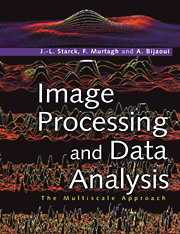Book contents
- Frontmatter
- Contents
- Preface
- 1 The wavelet transform
- 2 Multiresolution support and filtering
- 3 Deconvolution
- 4 1D signals and Euclidean data analysis
- 5 Geometric registration
- 6 Disparity analysis in remote sensing
- 7 Image compression
- 8 Object detection and point clustering
- 9 Multiscale vision models
- APPENDIX A Variance stabilization
- APPENDIX B Software information
- APPENDIX C Acronyms
- Bibliography
- Index
6 - Disparity analysis in remote sensing
Published online by Cambridge University Press: 30 October 2009
- Frontmatter
- Contents
- Preface
- 1 The wavelet transform
- 2 Multiresolution support and filtering
- 3 Deconvolution
- 4 1D signals and Euclidean data analysis
- 5 Geometric registration
- 6 Disparity analysis in remote sensing
- 7 Image compression
- 8 Object detection and point clustering
- 9 Multiscale vision models
- APPENDIX A Variance stabilization
- APPENDIX B Software information
- APPENDIX C Acronyms
- Bibliography
- Index
Summary
Definitions
Differences in images of real world scenes may be induced by the relative motion of the camera and the scene, by the relative displacement of two cameras or by the motion of objects in the scene. These differences are important because they contain enough information to allow a partial reconstruction of the three-dimensional structure of the scene from its two-dimensional projections. When such differences occur between two images, we say that there is a disparity between them, which may be represented by a vector field mapping one image onto the other (Barnard and Thompson, 1980). The evaluation of the disparity field has been called the correspondence problem (Duda and Hart, 1973). Time-varying images of the real world can provide kinematical, dynamical and structural information (Weng, Huang and Ahuja, 1989). The disparity field can be interpreted into meaningful statements about the scene, such as depth, velocity and shape.
Disparity analysis, in the sense of stereovision, may be broadly defined as the evaluation of the existing geometrical differences, in a given reference frame, between two or more images of the same or similar scenes. The differences in remote sensing are mainly the result of different imaging directions. The goal of the analysis is to assign disparities, which are represented as two-dimensional vectors in the image plane, to a collection of well-defined points in one of the images. Disparity analysis is useful for image understanding in several ways.
- Type
- Chapter
- Information
- Image Processing and Data AnalysisThe Multiscale Approach, pp. 185 - 216Publisher: Cambridge University PressPrint publication year: 1998



